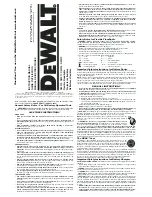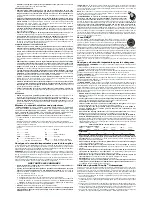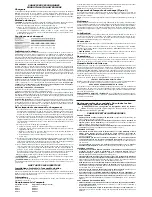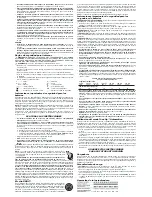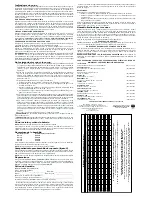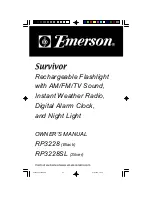
•
Do not expose charger to rain or snow.
•
Pull by plug rather than cord when disconnecting charger.
This will reduce risk of dam-
age to electric plug and cord.
•
Make sure that cord is located so that it will not be stepped on, tripped over, or oth-
erwise subjected to damage or stress.
•
Do not use an extension cord unless it is absolutely necessary.
Use of improper exten-
sion cord could result in risk of fire, electric shock, or electrocution.
•
An extension cord must have adequate wire size (AWG or American Wire Gauge) for
safety.
The smaller the gauge number of the wire, the greater the capacity of the cable, that
is 16 gauge has more capacity than 18 gauge. When using more than one extension to
make up the total length, be sure each individual extension contains at least the minimum
wire size.
Recommended Minimum Wire Size for Extension Cords
Total Length of Cord
25 ft.
50 ft.
75 ft.
100 ft.
125 ft.
150 ft.
175 ft.
7.6 m
15.2 m
22.9 m
30.5 m
38.1 m
45.7 m
53.3 m
Wire Size AWG
18 18
16
16
14
14
12
•
Do not place any object on top of charger or place the charger on a soft surface that
might block the ventilation slots and result in excessive internal heat.
Place the charg-
er in a position away from any heat source. The charger is ventilated through slots in the
top and the bottom of the housing.
•
Do not operate charger with damaged cord or plug
— have them replaced immediately.
•
Do not operate charger if it has received a sharp blow, been dropped, or otherwise
damaged in any way.
Take it to an authorized service center.
•
Do not disassemble charger; take it to an authorized service center when service or
repair is required.
Incorrect reassembly may result in a risk of electric shock, electrocution
or fire.
•
Disconnect the charger from the outlet before attempting any cleaning. This will
reduce the risk of electric shock.
Removing the battery pack will not reduce this risk.
•
NEVER
attempt to connect 2 chargers together.
•
The charger is designed to operate on standard household electrical power (120
Volts). Do not attempt to use it on any other voltage.
This does not apply to the vehic-
ular charger.
Using Automatic Tune-Up™ Mode
The Automatic Tune-Up™ Mode equalizes or balances the individual cells in the battery pack
allowing it to function at peak capacity. Battery packs should be tuned up weekly or after 10
charge/discharge cycles or whenever the pack no longer delivers the same amount of work.
To use the Automatic Tune-Up™, place the battery pack in the charger and leave it for at least
8 hours. The charger will cycle through the following modes.
1. The red light will blink continuously indicating that the 1-hour charge cycle has started.
2. When the 1-hour charge cycle is complete, the light will stay on continuously and will no
longer blink. This indicates that the pack is fully charged and can be used at this time.
3. Whenever the pack is left in the charger after the initial 1-hour charge, the charger will
begin the Automatic Tune-Up™ Mode. This mode continues up to 8 hours or until the indi-
vidual cells in the battery pack are equalized. The battery pack is ready for use and can be
removed at any time during the Tune-Up™ Mode.
4. Once the Automatic Tune-Up™ Mode is complete the charger will transition to a main-
tenance charge; the indicator light shuts off when the Automatic Tune-Up™ Mode is
complete.
SAVE THESE INSTRUCTIONS
FOR FUTURE USE
Chargers
Your tool uses a D
E
WALT charger. Your battery can be charged in D
E
WALT 1 Hour Chargers,
15 Minute Chargers or Vehicular 12 Volt Charger. Be sure to read all safety instructions before
using your charger. Consult the chart on the back cover of this manual for compatibility of
chargers and battery packs.
Charging Procedure
DANGER:
120 volts are present at charging terminals. Do not probe with conductive objects.
Electric shock or electrocution may result.
1. Plug the charger into an appropriate outlet as shown in Figure 1.
2. Insert the battery pack into the charger. The red (charging) light will blink continuously indi-
cating that the charging process has started.
3. The completion of charge will be indicated by the red light remaining ON continuously. The
pack is fully charged and may be used at this time or left in the charger.
Indicator Light Operation
Charge Indicators
Some chargers are designed to detect certain problems that can arise with battery packs.
Problems are indicated by the red light flashing at a fast rate. If this occurs, re-insert battery
pack into the charger. If the problem persists, try a different battery pack to determine if the
charger is OK. If the new pack charges correctly, then the original pack is defective and
should be returned to a service center or other collection site for recycling. If the new bat-
tery pack elicits the same trouble indication as the original, have the charger tested at an
authorized service center.
HOT/COLD PACK DELAY
Some chargers have a Hot/Cold Pack Delay feature: when the charger detects a battery that
is hot, it automatically starts a Hot Pack Delay, suspending charging until the battery has
cooled. After the battery has cooled, the charger automatically switches to the Pack Charging
mode. This feature ensures maximum battery life. The red light flashes long, then short while
in the Hot Pack Delay mode.
PROBLEM POWER LINE
Some chargers have a Problem Power Line indicator. When the charger is used with some
portable power sources such as generators or sources that convert DC to AC, the charger may
temporarily suspend operation,
flashing the red light with two fast blinks followed by a
pause
. This indicates the power source is out of limits.
LEAVING THE BATTERY PACK IN THE CHARGER
The charger and battery pack can be left connected with the red light glowing indefinitely. The
charger will keep the battery pack fresh and fully charged.
NOTE:
A battery pack will slowly lose its charge when kept out of the charger. If the battery
pack has not been kept on maintenance charge, it may need to be recharged before use. A
battery pack may also slowly lose its charge if left in a charger that is not plugged into an
appropriate AC source.
WEAK BATTERY PACKS:
Chargers can also detect a weak battery. Such batteries are still
usable but should not be expected to perform as much work. In such cases, about 10 seconds
after battery insertion, the charger will beep rapidly 8 times to indicate a weak battery condi-
tion. The charger will then go on to charge the battery to the highest capacity possible.
Important Charging Notes
1. Longest life and best performance can be obtained if the battery pack is charged when the
air temperature is between 65°F and 75°F (18°- 24°C). DO NOT charge the battery pack
in an air temperature below +40°F (+4.5°C), or above +105°F (+40.5°C). This is important
and will prevent serious damage to the battery pack.
2. The charger and battery pack may become warm to touch while charging. This is a nor-
mal condition, and does not indicate a problem. To facilitate the cooling of the battery pack
after use, avoid placing the charger or battery pack in a warm environment such as in a
metal shed, or an uninsulated trailer.
FIG. 1
FIG. 2
LENS HOLDER
PORTE-LENTILLE
SUJETADOR DE
LA LENTE
BULB
AMPOULE
BOMBILLA
BATTERY RELEASE BUTTON
BOUTON DE DÉGAGEMENT
DE LA PILE
BOTON DE LIBERACION
DE LA BATERIA
SPARE BULB STORAGE
RANGEMENT DE
L’AMPOULE
DE RECHANGE
COMPARTIMIENTO PARA
BOMBILLA DE
REPUESTO
POWER PACK
(NOT
INCLUDED)
ENSEMBLE
DE PILES
(NON COMPRIS)
BATERIA
(NO INCLUIDA)
SWITCH
INTERRUPTEUR
INTERRUPTOR
3. If the battery pack does not charge properly:
a. Check current at receptacle by plugging in a lamp or other appliance
b. Check to see if receptacle is connected to a light switch which turns power off when you
turn out the lights.
c. Move charger and battery pack to a location where the surrounding air temperature is
approximately 65°F - 75°F (18°- 24°C).
d. If charging problems persist, take the tool, battery pack and charger to your local
service center.
4. The battery pack should be recharged when it fails to produce sufficient power on jobs
which were easily done previously. DO NOT CONTINUE to use under these conditions.
Follow the charging procedure. You may also charge a partially used pack whenever you
desire with no adverse affect on the battery pack.
5. Under certain conditions, with the charger plugged into the power supply, the exposed
charging contacts inside the charger can be shorted by foreign material. Foreign materials
of a conductive nature such as, but not limited to, steel wool, aluminum foil, or any buildup
of metallic particles should be kept away from charger cavities. Always unplug the charg-
er from the power supply when there is no battery pack in the cavity. Unplug charger before
attempting to clean.
6. Do not freeze or immerse charger in water or any other liquid.
WARNING:
Don’t allow any liquid to get inside charger. Electric shock may result.
CAUTION:
Never attempt to open the battery pack for any reason. If the plastic housing of
the battery pack breaks or cracks, return to a service center for recycling.
Installing and Removing the Battery Pack
NOTE:
Make sure your battery pack is fully charged.
To insert the power pack into your flexible floodlight, slide it into the end of the light until it snaps
into place. To remove the power pack, depress the release buttons shown and withdraw the
power pack.
Switch
To turn the light on, slide the switch forward. To turn it off, slide the switch back.
Replacing the Light Bulb
Floodlight Cat. No
Replacement Bulb Cat. No.
DW913
DW9023
DW917
DW9043
DW918
DW9063
DW919
DW9083
To replace the light bulb, first unscrew the lens holder. Pull the bulb out of the spring, and insert
a new bulb. Reinstall lens holder.
NOTE:
Do not look directly into the flexible floodlight beam.
Spare Bulb Storage (Figure 2)
To store a bulb, unscrew the lens holder and remove it. Inside the body of the flexible floodlight
is the storage socket. To remove the bulb, pull it up and out of the storage area.
NOTE:
Removing a pack from the charger and immediately inserting it into the flexible floodlight
may weaken bulb life.
Three Year Limited Warranty
D
E
WALT will repair, without charge, any defects due to faulty materials or workmanship for
three years from the date of purchase. For warranty repair information, call 1-800-4-D
E
WALT.
This warranty does not apply to accessories or damage caused where repairs have been
made or attempted by others. This warranty gives you specific legal rights and you may have
other rights which vary in certain states or provinces.
In addition to the warranty, D
E
WALT tools are covered by our:
1 YEAR FREE SERVICE
D
E
WALT will maintain the tool and replace worn parts caused by normal use, for free, any time
during the first year after purchase.
90 DAY MONEY BACK GUARANTEE
If you are not completely satisfied with the performance of your D
E
WALT Power Tool, Laser,
or Nailer for any reason, you can return it within 90 days from the date of purchase with a
receipt for a full refund – no questions asked.
FREE WARNING LABEL REPLACEMENT:
If your warning labels become illegible or are
missing, call 1-800-4-DEWALT for a free replacement.
SI VOUS AVEZ DES QUESTIONS OU VOULEZ NOUS FAIRE PART DE VOS COMMEN-
TAIRES CONCERNANT CET OUTIL OU TOUT AUTRE OUTIL D
E
WALT, COMPOSEZ SANS
FRAIS LE :
1 800 433-9258.
Règles générales de sécurité – Outils à piles
AVERTISSEMENT!
Lire et comprendre toutes les directives, car le non-
respect des directives suivantes peut entraîner un choc électrique, un incendie
ou des blessures graves.
CONSERVER CES DIRECTIVES
AIRE DE TRAVAIL
•
L’aire de travail doit être propre et bien éclairée.
Les établis encombrés et le manque
de lumière peuvent entraîner des accidents.
•
Ne pas faire fonctionner des outils électriques dans des atmosphères explosives,
comme en présence de liquides, de gaz et de poussières inflammables.
Les outils
électriques produisent des étincelles qui peuvent enflammer la poussière ou les vapeurs.
•
Tenir les spectateurs, les enfants et les visiteurs à l’écart lorsqu’on utilise l’outil.
Les
distractions peuvent entraîner une perte de maîtrise.
RÈGLES DE SÉCURITÉ RELATIVES À L’ÉLECTRICITÉ
•
Manipuler le cordon avec soin. Ne jamais l'utiliser pour transporter l'outil. Tenir le
cordon à l’écart de la chaleur, de l’huile, des arêtes vives ou des pièces mobiles.
Remplacer immédiatement les cordons endommagés,
car ils peuvent causer un
incendie.
•
Un outil alimenté par piles, doté de piles intégrées ou d'un bloc-piles distinct, doit
être rechargé uniquement au moyen du chargeur indiqué pour la pile.
Un chargeur
peut convenir à un type de pile, mais créer un risque d'incendie lorsqu'il est utilisé avec une
autre pile.

